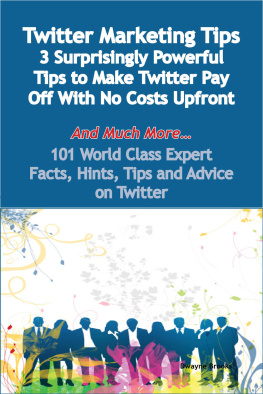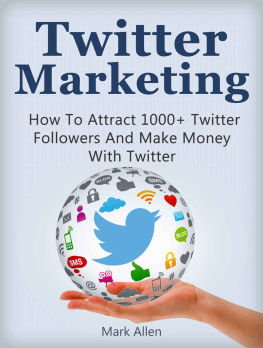Contents
Introduction
The web allows us to reach customers all over the world. Social media has changed not only how people connect with others, but also how customers feel about business es through a companys voice as presented to the world. Through social media, a business has the opportunity to reach its customers and prospects in ways that make the customer feel unique, important, and individual. This has changed how businesses identify and connect with consumers. It is essential to the success of a business that social media becomes an integral part of advertising, public relations, and gathering of demographics about its target audience.
Twitter is unique in its ability to provide equal benefit to both businesses and Twitter followers through a partnership of mutual interests. Twitter followers will spread the word about your companys promotions, advertisements, new products, business trends, anything you tweet about, and anything others tweet about you. It is one of the most predictable expenditures in promoting a company that is cost-effective in its ability to reach its target audience, providing a business with customers who spread the word for you in a lightning-fast media vehicle. Twitter is worldwide, instant word-of-mouth advertising that costs relatively little, and when used properly, pays off big.
Every savvy businessperson today knows that the way we communicate has changed drastically. It all began with email. Although attachments to an email message are a common way to share long documents, spreadsheets and pictures, it is common knowledge that the shorter and to-the-point an email message is, the more likely the message will be read, understood, and acted upon swiftly. No one wants to read a long drawn-out email message and most people wont. Time is too short and too valuable, and if your message is too long, you should expect the reader to miss the major points if you write them too far down in the message. In news writing lingo, a good email never buries the lead. The important message is usually less than two or three sentences long and often followed with bullet-point instructions. It is an efficient way to communicate tasks, news, and ideas. Most managers and staff read at least 30 emails on a slow day, and heads of departments and business owners receive constant emails throughout the day and night. It is not unusual to hear the familiar buzz or ping of a smart phone email message reverberate on every attendees phone at some point during a business meeting. This is a new world, and if you are not operating within the new rules of communication, or rather, outside of the old ones, you are not operating as efficiently as your competitors.
This is the very reason many businesses fail to see the value in a media like Twitter that requires the use of 140 characters or less. More is not better anymore, it is just more. These days, more is actually less. Too much information kills the message - not because it isnt important, but because after the first couple of sentences, youve lost your audience. We are in a nanosecond-need mode in our lives. We can distribute information that quickly; consequently, we feel a need to consume it that quickly. It is what we are not only accustomed to now, but what we demand. Consumers rarely accept anything less. I need it now and I need it fast and if I dont get it within 2 seconds, I am clicking over to another internet site, is the motto of most internet users. To convey a message in 140 characters or less is a brilliant concept that only requires some understanding of Twitter and the purpose it serves to business. Conveying the message properly is just one facet of Twitters advantages to business. The advantages a company receives from its use of Twitter are many, and most of them have not likely been fully discovered. Because of the unlimited possibilities of using Twitter in business and how to use conversations in real time to benefit your business goals, it is a brainstorming topic for a wide range of employees in your business from the most creative to the most analytical.
What is Twitter?
Twitter is a vehicle that allows its users to link people together who have common interests, ideas, opinions, preferences and needs. It is a way to receive and share information in real time. It is used by people, and through the use of Twitter, companies have the opportunity put the real voices of real people in their business publically forward a way that allows a business to reveal its personality and connect on a more individual level with its customers. Used to its potential, Twitter bonds a business to its customers in a way that removes the official, often tight corporate image and conveys the truth; businesses are made up of real people. Individual customers want to know who they are doing business with. They want to know that there is a real person behind the company image who cares about them. It makes a business friendly. People want to do business with someone who gives them personal attention and cares about what they care about. People are more likely to buy when they like you, not your product. In an advertising push, the goal may be to reassure the customer that they are cared about, and a statement may be printed in a newspaper or magazine, or voiced in a television commercial conveying We care about you, our customer. It is still seen as a promise, not necessarily truth; therefore, it is likely not as effective as showing a customer they are cared about by answering their tweets, listing to what their suggestions, complaints, and compliments, and responding to them in real time. Interacting with customers through Twitter proves to them that they are important to the business as individuals, not just a target demographic, and that proof means it is no longer just a promise, it is a proven fact. Customers will say, If someone at the business answers my question, listens to my concern, and returns my tweet personally, then I know they care about me. I will remain their customer. Using Twitter properly is a promise fulfilled to the customer, not simply a promise made.
Anybody who is anybody is on Twitter. If a major CEO is not on Twitter making his or her presence felt in the conversation in their business arena, then they are not connected with what is going on in business today and they should be. A presence in this unique social media venue is not only advantageous for top-level executives, it is essential. For the first time, customers, clients, and potential customers of your product or service have the opportunity to hear the voice of the big dog. To deny them that voice is to deny the importance of the very people that make business possible, no matter what field of business it is - even the Pope has a Twitter account and is connecting with his followers. For owners of small businesses, it is another way to connect with your community. Successful small business owners already devote their time and knowledge pitching in to help develop community interests. Your community is on Twitter, just waiting for you to join in and listen to their interests and needs
. It is a mutually beneficial relationship; the community tells you what they want and need, and you can provide it to them in the form of additional products and services.
Twitter Symbols, Language, and Uses
Twitter has its own language, but it is easy to learn. Some call the world of Twitter the Twitterverse. Perhaps it is a play on words somewhere between universe, and a Twitter verse - not an entire song, just a little verse to get you singing the tune. So, lets learn the language of this catchy little tune
It is important to be familiar with the simple and easy-to-understand terms, symbols, and methods of communication on Twitter before entering into a discussion on how to best use Twitter for business. There are just nine main terms and concepts needed to help facilitate the discussion: tweet, retweet, favorite, mention, timeline, reply, hashtag, links, and followers .
Next page










